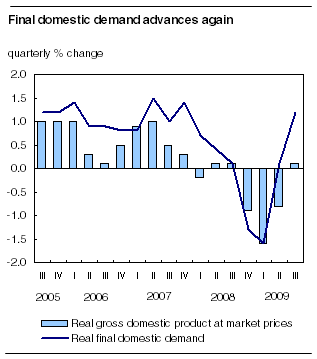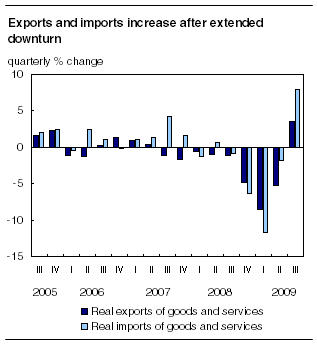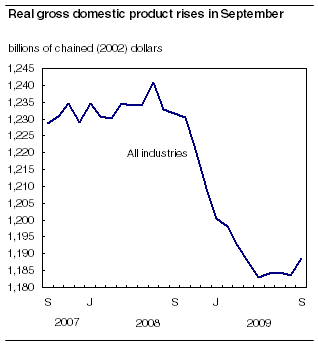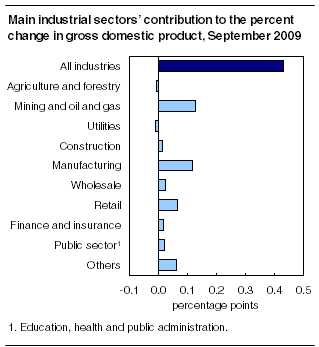Common menu bar links
Canadian economic accounts
Archived Content
Information identified as archived is provided for reference, research or recordkeeping purposes. It is not subject to the Government of Canada Web Standards and has not been altered or updated since it was archived. Please "contact us" to request a format other than those available.
Real gross domestic product (GDP) increased 0.1% in the third quarter, the first quarterly gain since the third quarter of 2008. Final domestic demand advanced 1.2%, as capital investment and personal expenditures both increased. Real GDP was up 0.4% in September, as most major industrial sectors increased their production.
Final domestic demand was bolstered by a second consecutive quarterly gain in personal expenditures and the first expansion in business capital expenditure since the fourth quarter of 2007. Export and import volumes both increased after many quarters of decline.

The output of services-producing industries increased 0.6%, with the wholesale and retail trade sectors and real estate agents and brokers leading the way. Goods-producing industries (-1.4%) continued their downward trend that started in the third quarter of 2007, with the mining and oil and gas extraction contributing the most to the decrease as a result of temporary shutdowns.

Note to readers
Percentage changes for expenditure-based and industry-based statistics (such as personal expenditures, investment, exports, imports and output) are calculated using volume measures that are adjusted for price variations. Percentage changes for income-based statistics (such as labour income, corporate profits and farm income) are calculated using nominal values, that is, not adjusted for price variations.
The Frequently asked questions section on the National economic accounts module of our website has been updated with a series of questions and answers pertaining to recent economic events and how they are treated within the national economic accounts.
Additional data tables are available in Canadian Economic Accounts Quarterly Review (13-010-X, free).
The Canadian economy expanded at an annualized rate of 0.4% in the third quarter, compared with a 2.8% increase for the US economy.
Table 1
| Change | Annualized change | Year-over-year change | |
|---|---|---|---|
| % | |||
| First quarter 2008 | -0.2 | -0.7 | 1.7 |
| Second quarter 2008 | 0.1 | 0.3 | 0.7 |
| Third quarter 2008 | 0.1 | 0.4 | 0.3 |
| Fourth quarter 2008 | -0.9 | -3.7 | -1.0 |
| First quarter 2009 | -1.6 | -6.2 | -2.3 |
| Second quarter 2009 | -0.8 | -3.1 | -3.2 |
| Third quarter 2009 | 0.1 | 0.4 | -3.2 |
Personal spending advances
Consumer spending on goods and services rose 0.8%, the biggest increase since the fourth quarter of 2007. Households increased their spending on durable goods (+2.4%), particularly on new and used motor vehicles and on furniture. Purchases of services advanced 0.7%, similar to the previous quarter.
Investment in machinery and equipment increases
Business investment in machinery and equipment grew 5.9% in the third quarter, following five quarters of decline. Outlays on motor vehicles and industrial machinery led the surge.
Businesses reduced investment in non-residential structures by 3.6%, the fourth consecutive quarterly decline.
Investment in residential structures advanced for a second consecutive quarter. A 13% gain pushed ownership transfer costs related to housing resale activity to a record high. Investment in new housing construction fell 4.2%, following steeper declines in the first two quarters of the year. Renovation activity grew 2.8%, similar to the second quarter increase.
Government investment in buildings and engineering projects grew by 5.6%, the fourth consecutive quarter in which growth has been 4% or higher.
Export demand grows
Exports of goods and services advanced 3.6% in the third quarter, the first increase since the second quarter of 2007. A 28% jump in exports of automotive products was the major contributor to the overall strength. Nonetheless, automobile exports were 29% lower than the third quarter of 2008. Energy product exports were up (+9.2%) in the quarter.

Imports grew 8.0% in the third quarter, following four consecutive quarters of decline. While gains were widespread, increases in the imports of automobile products (+25%) as well as machinery and equipment (+9.8%) were notable.
Non-farm inventories fall again
Non-farm inventories were drawn down for the third consecutive quarter. Manufacturing inventories were the main contributor to the draw down.
Farm inventories accumulated in the third quarter, after a drop in the second quarter.
The economy wide stock-to-sales ratio edged down, reversing the upward trend of the previous five quarters. Businesses held inventories equivalent to 69 days of sales, down from 71 days in the second quarter.
Prices up in the third quarter
The price of goods and services produced in Canada was up 0.8%, following a small increase in the second quarter. The price of final domestic demand edged down 0.1% in the third quarter, as prices for machinery and equipment fell 3.3%. Prices for consumer goods and services rose 0.2%.
Purchasing power increases
Real gross domestic income, a measure of the purchasing power Canada acquires from its production of goods and services, grew 0.8% in the third quarter, following four quarters of decline. Canada's terms of trade, a measure of export prices relative to import prices, strengthened for the second consecutive quarter, as import prices (-3.7%) fell more quickly than export prices (-1.4%).
Table 2
| Change | Annualized change | Year-over-year change | |
|---|---|---|---|
| % | |||
| First quarter 2008 | 0.5 | 2.2 | 4.0 |
| Second quarter 2008 | 1.3 | 5.5 | 3.9 |
| Third quarter 2008 | -0.3 | -1.1 | 3.1 |
| Fourth quarter 2008 | -4.3 | -16.0 | -2.7 |
| First quarter 2009 | -3.4 | -12.9 | -6.5 |
| Second quarter 2009 | -0.4 | -1.6 | -8.2 |
| Third quarter 2009 | 0.8 | 3.3 | -7.1 |
Economy-wide incomes return to growth
Nominal GDP increased 0.8% in the quarter, led by a 5.2% gain in corporate profits. Both had registered decreases over the previous three quarters. Non-financial and financial industries recorded higher profits in the third quarter.
Labour income (in nominal terms) was virtually unchanged, after decreases in the first two quarters of 2009. Employment was down in the third quarter while average hours worked were up slightly. An increase in government sector labour income offset a decrease in the business sector.
Personal saving rate moves downward
The personal saving rate was 4.8%, down from the previous quarter, as personal outlays advanced 0.8%. Personal income increased 0.3% as income from government transfers rose 1.4%.
Gross domestic product by industry, September 2009
Real gross domestic product rose 0.4% in September, after levelling off between June and August. Most major industrial sectors increased their production in September. Goods-producing industries advanced 0.9%, the first increase since July 2008, bolstered by mining and manufacturing. The services-producing industries continued to grow (+0.3%), on the strength of retail trade in particular. Conversely, accommodation and food services, utilities as well as agriculture retreated.

The output of the mining sector excluding oil and gas extraction grew 5.6%, mainly as a result of the reopening of some mines after shutdowns in July and August. Both non-metallic mineral mines (which includes diamonds) and iron ore mines increased their production substantially. Oil and gas extraction advanced 0.9% as a result of an increase in petroleum extraction, while natural gas facilities lowered their production.
The 1.1% increase in manufacturing output was widespread, with 15 of the 21 major groups advancing. Notable increases were recorded in the manufacturing of primary metals, beverage and tobacco products, plastics and rubber products as well as transportation equipment.
Value added in the retail trade sector rose 1.1% in September, with gains in most of the trade groups. Automotive products, as well as food and beverage stores, reported appreciable increases. The volume of activity in wholesaling advanced 0.4% in September, reflecting the strength in exports and manufacturing as well as the increased demand from retailers.
Construction activity was up 0.2% in September. Residential building construction and engineering and repairs work rose, while non-residential building construction retreated. Increased activity in the home resale market translated into a 2.8% advance in the output of real estate agents and brokers.

The accommodation and food services sector retreated, despite an increase in the number of international travellers coming to Canada. The decline in agriculture was largely attributable to weak crop production. Utilities were down due to weaker demand for both electricity and natural gas.
Products, services and contact information
Detailed analysis and tables
The National economic accounts module, accessible from the home page of our website, features an up-to-date portrait of national and provincial economies and their structure.
Detailed analysis on today's releases from the national accounts, including additional tables, can be found in the third quarter 2009 issue of Canadian Economic Accounts Quarterly Review, Vol. 8, no. 3 (13-010-X, free), which is now available from the Publications module of our website.
Gross domestic product by industry
Available on CANSIM: table 379-0027.
Definitions, data sources and methods: survey number, including related surveys, 1301.
The September 2009 issue of Gross Domestic Product by Industry, Vol. 23, no. 9 (15-001-X, free) is now available from the Publications module of our website.
For more information or to order data, contact our dissemination officer (613-951-4623; toll-free 1-800-887-4623; iad-info-dci@statcan.gc.ca). To enquire about the concepts, methods or data quality of this release, contact Bernard Lefrançois (613-951-3622), Industry Accounts Division.
Income and expenditure accounts
Available on CANSIM: tables 380-0001 to 380-0017, 380-0019 to 380-0035, 380-0056, 380-0059 to 380-0062 and 382-0006.
Definitions, data sources and methods: survey numbers, including related surveys, 1901 and 2602.
The National Income and Expenditure Accounts: Data Tables (13-019-X, free), and Estimates of Labour Income: Data Tables (13-021-X, free) are also now available from the Publications module of our website.
For more information, or to enquire about the concepts, methods or data quality of this release, consult the Guide to the Income and Expenditure Accounts (13-017-X, free) or contact the information officer (613-951-3640; iead-info-dcrd@statcan.gc.ca), Income and Expenditure Accounts Division.
Table 3
| Second quarter 2008 | Third quarter 2008 | Fourth quarter 2008 | First quarter 2009 | Second quarter 2009 | Third quarter 2009 | 2007 | 2008 | |
|---|---|---|---|---|---|---|---|---|
| Seasonally adjusted at annual rates | ||||||||
| millions of dollars at current prices | ||||||||
| Gross domestic product by income and by expenditure | ||||||||
| Wages, salaries and supplementary labour income | 820,916 | 827,116 | 831,936 | 824,492 | 820,352 | 820,412 | 784,839 | 823,116 |
| 1.0 | 0.8 | 0.6 | -0.9 | -0.5 | 0.0 | 5.6 | 4.9 | |
| Corporation profits before taxes | 229,532 | 237,708 | 182,900 | 147,508 | 131,168 | 137,952 | 204,131 | 215,799 |
| 7.7 | 3.6 | -23.1 | -19.4 | -11.1 | 5.2 | 4.1 | 5.7 | |
| Interest and miscellaneous investment income | 85,660 | 86,136 | 77,568 | 66,036 | 66,108 | 70,392 | 71,847 | 81,484 |
| 11.9 | 0.6 | -9.9 | -14.9 | 0.1 | 6.5 | 7.7 | 13.4 | |
| Net income of unincorporated business | 95,500 | 97,860 | 98,108 | 96,204 | 98,168 | 99,924 | 90,407 | 96,246 |
| 2.1 | 2.5 | 0.3 | -1.9 | 2.0 | 1.8 | 4.4 | 6.5 | |
| Taxes less subsidies | 166,016 | 166,464 | 163,220 | 160,076 | 161,816 | 162,888 | 166,443 | 165,017 |
| 1.0 | 0.3 | -1.9 | -1.9 | 1.1 | 0.7 | 3.7 | -0.9 | |
| Personal disposable income | 948,596 | 955,512 | 960,852 | 957,152 | 968,324 | 971,120 | 897,562 | 950,948 |
| 1.0 | 0.7 | 0.6 | -0.4 | 1.2 | 0.3 | 5.3 | 5.9 | |
| Personal saving rate2 | 3.4 | 3.1 | 4.9 | 4.9 | 5.5 | 4.8 | 2.5 | 3.7 |
| ... | ... | ... | ... | ... | ... | ... | ... | |
| millions of chained (2002) dollars | ||||||||
| Personal expenditure on consumer goods and services | 812,310 | 813,469 | 807,018 | 804,161 | 807,682 | 813,835 | 787,063 | 810,723 |
| 0.3 | 0.1 | -0.8 | -0.4 | 0.4 | 0.8 | 4.6 | 3.0 | |
| Government current expenditure on goods and services | 264,477 | 264,462 | 266,084 | 267,505 | 269,666 | 272,967 | 254,740 | 264,142 |
| 1.1 | -0.0 | 0.6 | 0.5 | 0.8 | 1.2 | 3.3 | 3.7 | |
| Gross fixed capital formation | 318,118 | 318,616 | 305,999 | 286,610 | 282,922 | 288,951 | 312,482 | 315,265 |
| -0.1 | 0.2 | -4.0 | -6.3 | -1.3 | 2.1 | 3.7 | 0.9 | |
| Investment in inventories | 14,466 | 14,872 | 10,386 | -10,570 | -9,159 | -5,815 | 15,006 | 12,272 |
| ... | ... | ... | ... | ... | ... | ... | ... | |
| Exports of goods and services | 493,352 | 488,152 | 464,964 | 425,584 | 403,076 | 417,723 | 510,323 | 486,255 |
| -1.0 | -1.1 | -4.8 | -8.5 | -5.3 | 3.6 | 1.1 | -4.7 | |
| Imports of goods and services | 589,968 | 584,824 | 547,196 | 483,115 | 474,549 | 512,501 | 572,078 | 576,905 |
| 0.7 | -0.9 | -6.4 | -11.7 | -1.8 | 8.0 | 5.8 | 0.8 | |
| Gross domestic product at market prices | 1,324,093 | 1,325,452 | 1,312,880 | 1,292,079 | 1,282,096 | 1,283,227 | 1,315,907 | 1,321,360 |
| 0.1 | 0.1 | -0.9 | -1.6 | -0.8 | 0.1 | 2.5 | 0.4 | |
| Gross domestic product by industry at basic prices | ||||||||
| Goods producing industries | 365,936 | 365,810 | 356,397 | 338,882 | 325,331 | 320,934 | 373,164 | 363,625 |
| -0.1 | -0.0 | -2.6 | -4.9 | -4.0 | -1.4 | 0.7 | -2.6 | |
| Industrial production | 263,941 | 263,682 | 255,369 | 242,030 | 230,791 | 227,529 | 273,529 | 261,955 |
| -0.3 | -0.1 | -3.2 | -5.2 | -4.6 | -1.4 | 0.1 | -4.2 | |
| Energy sector | 83,929 | 84,492 | 83,264 | 81,884 | 77,489 | 76,748 | 86,732 | 84,147 |
| -1.1 | 0.7 | -1.5 | -1.7 | -5.4 | -1.0 | 1.1 | -3.0 | |
| Manufacturing | 174,593 | 172,800 | 165,643 | 153,128 | 147,573 | 147,230 | 182,297 | 171,906 |
| 0.0 | -1.0 | -4.1 | -7.6 | -3.6 | -0.2 | -1.3 | -5.7 | |
| Non-durable manufacturing | 68,532 | 67,745 | 66,018 | 64,124 | 62,405 | 62,432 | 70,835 | 67,604 |
| 0.6 | -1.1 | -2.5 | -2.9 | -2.7 | 0.0 | -2.3 | -4.6 | |
| Durable manufacturing | 106,397 | 105,400 | 99,819 | 88,794 | 84,889 | 84,498 | 111,904 | 104,617 |
| -0.4 | -0.9 | -5.3 | -11.0 | -4.4 | -0.5 | -0.5 | -6.5 | |
| Construction | 74,386 | 75,016 | 74,362 | 71,191 | 69,863 | 69,591 | 72,414 | 74,452 |
| 0.5 | 0.8 | -0.9 | -4.3 | -1.9 | -0.4 | 3.9 | 2.8 | |
| Services producing industries | 870,737 | 871,586 | 866,563 | 861,716 | 863,741 | 869,179 | 850,999 | 869,154 |
| 0.3 | 0.1 | -0.6 | -0.6 | 0.2 | 0.6 | 3.6 | 2.1 | |
| Wholesale trade | 72,201 | 70,795 | 67,321 | 64,641 | 64,771 | 66,058 | 70,318 | 70,693 |
| -0.4 | -1.9 | -4.9 | -4.0 | 0.2 | 2.0 | 5.3 | 0.5 | |
| Retail trade | 75,278 | 75,346 | 74,186 | 73,462 | 73,656 | 74,604 | 72,808 | 74,963 |
| 0.3 | 0.1 | -1.5 | -1.0 | 0.3 | 1.3 | 5.4 | 3.0 | |
| Transportation and warehousing | 58,778 | 58,635 | 57,425 | 55,975 | 55,321 | 55,900 | 58,045 | 58,323 |
| 0.6 | -0.2 | -2.1 | -2.5 | -1.2 | 1.0 | 1.9 | 0.5 | |
| Finance, insurance, real estate and renting | 246,472 | 247,014 | 246,830 | 247,182 | 250,967 | 253,434 | 241,258 | 246,623 |
| 0.1 | 0.2 | -0.1 | 0.1 | 1.5 | 1.0 | 4.0 | 2.2 | |
| Information and communication technologies | 59,598 | 59,741 | 59,629 | 58,897 | 58,623 | 58,581 | 57,816 | 59,536 |
| 0.7 | 0.2 | -0.2 | -1.2 | -0.5 | -0.1 | 4.4 | 3.0 | |
Table 4
| April 2009r | May 2009r | June 2009r | July 2009r | August 2009r | September 2009p | September 2009 | September 2008 to September 2009 | |
|---|---|---|---|---|---|---|---|---|
| Seasonally adjusted | ||||||||
| month-to-month % change | $ millions¹ | % change | ||||||
| All industries | -0.4 | -0.4 | 0.1 | 0.0 | -0.1 | 0.4 | 1,188,603 | -3.5 |
| Goods-producing industries | -1.6 | -1.4 | -0.6 | -0.3 | -0.7 | 0.9 | 322,035 | -11.3 |
| Agriculture, forestry, fishing and hunting | -1.3 | -1.4 | -1.3 | -1.8 | -2.3 | -0.5 | 23,436 | -12.7 |
| Mining and oil and gas extraction | -2.9 | -1.9 | -1.0 | -1.0 | -2.0 | 1.8 | 49,078 | -12.1 |
| Utilities | -2.3 | -0.8 | -0.8 | -2.3 | 2.0 | -0.4 | 28,949 | -6.4 |
| Construction | -0.5 | -0.5 | -0.5 | -0.1 | 0.3 | 0.2 | 69,760 | -6.9 |
| Manufacturing | -1.3 | -1.7 | -0.2 | 0.6 | -0.7 | 1.1 | 147,931 | -13.9 |
| Services-producing industries | 0.1 | 0.0 | 0.4 | 0.2 | 0.2 | 0.3 | 871,204 | -0.0 |
| Wholesale trade | 0.6 | 0.5 | 0.9 | 1.3 | -0.3 | 0.4 | 66,169 | -5.8 |
| Retail trade | -0.6 | 0.5 | 0.6 | -0.1 | 0.6 | 1.1 | 75,293 | -0.2 |
| Transportation and warehousing | -0.8 | -0.7 | 1.0 | 0.2 | 0.4 | 0.6 | 56,190 | -3.6 |
| Information and cultural industries | -0.3 | -0.3 | -0.2 | -0.1 | -0.1 | -0.1 | 45,736 | -1.4 |
| Finance, insurance and real estate | 0.6 | 0.4 | 0.7 | 0.2 | 0.1 | 0.3 | 254,088 | 2.7 |
| Professional, scientific and technical services | -0.0 | -0.3 | -0.2 | 0.0 | -0.1 | -0.1 | 60,144 | -1.7 |
| Administrative and waste management services | -0.5 | -0.8 | -0.6 | -0.4 | -0.2 | -0.2 | 29,626 | -5.1 |
| Education services | -0.0 | -0.1 | 0.1 | 0.0 | 0.1 | -0.0 | 60,858 | 0.6 |
| Health care and social assistance | 0.1 | 0.2 | 0.2 | 0.2 | 0.3 | 0.1 | 81,330 | 2.4 |
| Arts, entertainment and recreation | 0.4 | -2.3 | 0.5 | 0.1 | 0.3 | 0.6 | 11,151 | 0.1 |
| Accommodation and food services | -0.1 | -0.9 | -0.3 | 0.6 | 0.6 | -0.4 | 26,644 | -1.4 |
| Other services (except public administration) | -0.1 | -0.0 | -0.1 | -0.1 | 0.0 | -0.0 | 32,165 | -0.4 |
| Public administration | 0.1 | 0.2 | 0.1 | -0.3 | 0.7 | 0.3 | 72,229 | 1.6 |
| Other aggregations | ||||||||
| Industrial production | -2.0 | -1.7 | -0.5 | -0.3 | -0.9 | 1.2 | 228,601 | -12.4 |
| Non-durable manufacturing industries | -2.5 | 0.6 | 0.8 | -0.7 | -0.4 | 1.0 | 62,746 | -7.1 |
| Durable manufacturing industries | -0.3 | -3.5 | -0.9 | 1.6 | -1.0 | 1.2 | 84,881 | -18.8 |
| Business sector industries | -0.5 | -0.5 | 0.1 | 0.0 | -0.1 | 0.5 | 984,725 | -4.4 |
| Non-business sector industries | 0.0 | 0.1 | 0.1 | -0.0 | 0.3 | 0.2 | 203,954 | 1.3 |
| Information and communication technologies industries | 0.2 | -0.5 | 0.0 | -0.0 | 0.4 | -0.5 | 58,467 | -2.2 |
| Energy sector | -3.4 | -1.5 | 1.2 | -0.9 | -0.9 | 0.8 | 76,897 | -7.8 |
Table 5
| Second quarter 2008 | Third quarter 2008 | Fourth quarter 2008 | First quarter 2009 | Second quarter 2009 | Third quarter 2009 | |
|---|---|---|---|---|---|---|
| Using seasonally adjusted data (2002=100) | ||||||
| quarterly % change | ||||||
| Personal expenditure on consumer goods and services | 0.8 | 0.9 | -0.5 | 0.1 | 0.2 | 0.2 |
| Business gross fixed capital formation | 1.4 | 1.3 | 3.3 | 0.3 | -1.2 | -0.9 |
| Exports of goods and services | 7.4 | 3.1 | -4.1 | -7.2 | -3.2 | -1.4 |
| Imports of goods and services | 3.8 | 4.5 | 5.7 | -1.6 | -4.2 | -3.7 |
| Gross domestic product at market prices | 2.4 | 0.8 | -2.9 | -1.5 | 0.2 | 0.8 |
| Final domestic demand | 1.0 | 1.1 | 0.5 | 0.2 | 0.0 | -0.1 |
Table 6
| Second quarter 2008 | Third quarter 2008 | Fourth quarter 2008 | First quarter 2009 | Second quarter 2009 | Third quarter 2009 | |
|---|---|---|---|---|---|---|
| Using seasonally adjusted data (2002=100) | ||||||
| year-over-year % change | ||||||
| Personal expenditure on consumer goods and services | 1.5 | 2.3 | 1.6 | 1.3 | 0.6 | -0.1 |
| Business gross fixed capital formation | 1.8 | 3.2 | 7.1 | 6.5 | 3.7 | 1.4 |
| Exports of goods and services | 10.8 | 17.6 | 12.4 | -1.4 | -11.1 | -15.0 |
| Imports of goods and services | 1.1 | 9.1 | 18.9 | 12.8 | 4.2 | -4.0 |
| Gross domestic product at market prices | 4.9 | 5.8 | 1.6 | -1.3 | -3.4 | -3.5 |
| Final domestic demand | 1.6 | 3.1 | 3.3 | 2.8 | 1.8 | 0.6 |

